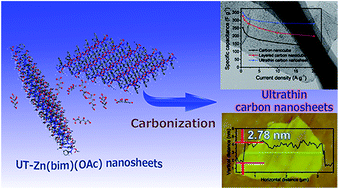当前位置:
X-MOL 学术
›
J. Mater. Chem. A
›
论文详情
Our official English website, www.x-mol.net, welcomes your feedback! (Note: you will need to create a separate account there.)
High-yield bottom-up synthesis of 2D metal–organic frameworks and their derived ultrathin carbon nanosheets for energy storage†
Journal of Materials Chemistry A ( IF 11.9 ) Pub Date : 2017-12-27 00:00:00 , DOI: 10.1039/c7ta06916b Kuangmin Zhao 1, 2, 3, 4, 5 , Suqin Liu 1, 2, 3, 4 , Guanying Ye 1, 2, 3, 4, 5 , Qingmeng Gan 1, 2, 3, 4, 5 , Zhi Zhou 3, 4, 6 , Zhen He 1, 2, 3, 4
Journal of Materials Chemistry A ( IF 11.9 ) Pub Date : 2017-12-27 00:00:00 , DOI: 10.1039/c7ta06916b Kuangmin Zhao 1, 2, 3, 4, 5 , Suqin Liu 1, 2, 3, 4 , Guanying Ye 1, 2, 3, 4, 5 , Qingmeng Gan 1, 2, 3, 4, 5 , Zhi Zhou 3, 4, 6 , Zhen He 1, 2, 3, 4
Affiliation

|
Two-dimensional (2D) metal–organic frameworks (MOFs) have been considered as promising precursors for the synthesis of 2D carbon materials for energy storage. However, the high costs and low yields of the synthetic methods for 2D MOFs are major obstacles for the preparation of 2D carbon materials from 2D MOFs. Herein, we report a facile and low-cost bottom-up synthesis of ultrathin Zn(bim)(OAc) MOF nanosheets (with a thickness of ∼5 nm and a high yield of ∼65%) and their derived N-doped porous ultrathin (2.5 ± 0.8 nm) carbon nanosheets (UT-CNSs) for energy storage. The UT-CNSs exhibit a capacitance of 278 F g−1 at a high current density of 10 A g−1, which is the highest among the reported MOF-derived carbon materials for supercapacitor electrodes. In addition, the UT-CNSs also exhibit a high reversible capacity of 553 mA h g−1 at 10 A g−1 and retain 100% coulombic efficiency after 1000 cycles at 2 A g−1 as an anode material for lithium ion batteries. The superior electrochemical properties of the UT-CNSs, especially at high current densities, are mainly due to their ultrathin morphology, large specific surface area, high conductivity, and suitable porous structure. This work provides a new strategy for the high-yield and low-cost synthesis of ultrathin MOF nanosheets as well as 2D carbon materials and their metal or metal oxide composites for various applications.
中文翻译:

二维金属-有机骨架及其衍生的超薄碳纳米片的高产率自下而上合成,用于储能†
二维(2D)金属有机框架(MOF)被认为是合成2D碳材料以存储能量的有前途的前体。然而,用于2D MOF的合成方法的高成本和低产率是从2D MOF制备2D碳材料的主要障碍。本文中,我们报道了一种低成本,低成本,自下而上的超薄Zn(bim)(OAc)MOF纳米片的合成方法(厚度约5 nm,高产率约65%)及其衍生的N掺杂多孔超薄材料。 (2.5±0.8 nm)碳纳米片(UT-CNS),用于存储能量。的UT-CNSS表现出278 F G的电容-1以10A g的高电流密度-1,这是在报道的MOF衍生的超级电容器电极用碳材料中最高的。此外,UT-CNS在10 A g -1下还表现出553 mA hg -1的高可逆容量,并在2 A g -1下循环1000次后保留100%的库伦效率,作为锂离子电池的负极材料。UT-CNS的优异电化学性能,特别是在高电流密度下,主要是由于它们的超薄形态,大比表面积,高电导率和合适的多孔结构。这项工作为超薄MOF纳米片以及2D碳材料及其金属或金属氧化物复合材料的高产量和低成本合成提供了一种新策略,可用于各种应用。
更新日期:2017-12-27
中文翻译:

二维金属-有机骨架及其衍生的超薄碳纳米片的高产率自下而上合成,用于储能†
二维(2D)金属有机框架(MOF)被认为是合成2D碳材料以存储能量的有前途的前体。然而,用于2D MOF的合成方法的高成本和低产率是从2D MOF制备2D碳材料的主要障碍。本文中,我们报道了一种低成本,低成本,自下而上的超薄Zn(bim)(OAc)MOF纳米片的合成方法(厚度约5 nm,高产率约65%)及其衍生的N掺杂多孔超薄材料。 (2.5±0.8 nm)碳纳米片(UT-CNS),用于存储能量。的UT-CNSS表现出278 F G的电容-1以10A g的高电流密度-1,这是在报道的MOF衍生的超级电容器电极用碳材料中最高的。此外,UT-CNS在10 A g -1下还表现出553 mA hg -1的高可逆容量,并在2 A g -1下循环1000次后保留100%的库伦效率,作为锂离子电池的负极材料。UT-CNS的优异电化学性能,特别是在高电流密度下,主要是由于它们的超薄形态,大比表面积,高电导率和合适的多孔结构。这项工作为超薄MOF纳米片以及2D碳材料及其金属或金属氧化物复合材料的高产量和低成本合成提供了一种新策略,可用于各种应用。


























 京公网安备 11010802027423号
京公网安备 11010802027423号